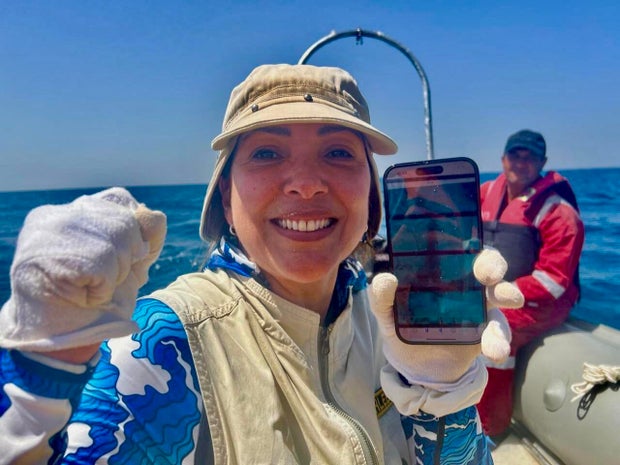Cairo — Archaeologists say they have discovered evidence of an ancient, long-submerged Mediterranean port that was linked to the Taposiris Magna Temple near Egypt's northern coastal city of Alexandria. The Egyptian Ministry of Tourism and Antiquities announced the discovery last week, expanding on what's known about the temple complex about 30 miles west of Alexandria that dates to the Ptolemaic period, more than 2,000 years ago.
The Egyptian-Dominican archaeological mission, led by Dr. Kathleen Martinez from the Universidad Nacional Pedro Henriquez Ureña, along with Dr. Robert Ballard, who located the Titanic shipwreck in 1985, has been conducting geological and archaeological surveys of the coastal area surrounding the temple.
Working in collaboration with Dr. Larry Mayer, from the University of New Hampshire, and the Egyptian Navy Hydrographic Department (ENHD) and the Egyptian Department of Underwater Antiquities, it was this team that uncovered the evidence of an ancient submerged port.
 The ancient Taposiris Magna Temple, west of Egypt's northern coastal city of Alexandria, is seen in the background, as a worker ascends a ladder leading into a tunnel that was discovered, believed to have once connected the temple to an ancient, long-submerged port.
Dr. Kathleen Martinez
The ancient Taposiris Magna Temple, west of Egypt's northern coastal city of Alexandria, is seen in the background, as a worker ascends a ladder leading into a tunnel that was discovered, believed to have once connected the temple to an ancient, long-submerged port.
Dr. Kathleen Martinez
Martinez told CBS News that after mapping the seabed with state-of-the-art sonar technologies, and then using software to simulate pre-submersion conditions, the team revealed a submerged ancient shoreline about 2.5 miles from the present coast, including a site with an old inner harbor that would have been protected by coral reefs.
Their research also revealed an extension of a tunnel linking the temple, the remains of which are about half of a mile from the current coastline, to the old port. The tunnel extended to an area known as "Salam 5," where divers found basalt base fragments similar to those from statues inside the sanctuary.
The team also found several stone and metal anchors of various shapes and sizes scattered near the reef, along with numerous broken amphorae that were recovered from inside the sunken harbor, all dating to the Ptolemaic period.
Martinez told CBS News that, along with the discovery of seven shafts connected to an underground passage near the sanctuary of Taposiris Magna, linked with other subsurface structures and some contemporary buildings in front of the sanctuary, the findings "strongly indicate that Taposiris Magna functioned as an active maritime zone with at least an inner harbor in antiquity."
"The development of peripheral harbors, towards the decongestion of the central one in Alexandria, would be a matter of necessity. Taposiris Magna would be part of the network of peripheral harbor towns, providing access to Egypt from the west, and assisting in the distribution of Egyptian products across the Mediterranean," she said.
 Divers working with the Egyptian-Dominican archaeological mission survey an anchor on the seafloor off Egypt's northern Mediterranean coast, in a site believed to have been a port more than 2,000 years ago.
Dr. Kathleen Martinez
Divers working with the Egyptian-Dominican archaeological mission survey an anchor on the seafloor off Egypt's northern Mediterranean coast, in a site believed to have been a port more than 2,000 years ago.
Dr. Kathleen Martinez
As no ancient texts refer to a harbor at Taposiris Magna, the results of the research represent a significant contribution of new knowledge, throwing open an entirely new chapter in the history of the site, Martinez said.
The quest for Cleopatra's tomb
But while discovering the port is important, she's looking for something else. Like many other archaeologists, Martinez wants to find the tomb of Egypt's last queen, Cleopatra VII, who ruled from about 51 B.C. - 30 B.C.
While many of her contemporaries in the field have long focused their hunt for Cleopatra's tomb among the ruins of Alexandria's Royal Quarters, Martinez has trained her sights for the last 20 years on Taposiris Magna.
"I dedicated 10 years previous to that to studying Cleopatra's life and death," said Martinez.
The ancient queen allied herself with Roman general Mark Antony after Julius Caesar's death, to jointly face Caesar's heir Octavian (or Octavius).
When they were defeated at the Battle of Actium, they fled to Egypt. Octavius pursued them, and in 30 B.C. they both committed suicide separately, but they are believed by many historians to have been buried together in Alexandria.
Martinez, however, believes the tomb is actually in Taposiris Magna, about 30 miles further southwest down Egypt's Mediterranean coast. She considers it "the perfect final resting place for Queen Cleopatra."
When she started the project, Martinez presented her hypothesis to Egyptian officials.
"Of course, they didn't believe me," she told CBS News.
She said she predicted they would find a necropolis at the site, likely from the time of Cleopatra.
"We did," she told CBS News. "We have already discovered and excavated 21 catacombs. We have a projection that at least we have 20 or 25 more… We have more than 600 human remains and more than 30 mummies… And we will discover the tomb [of Cleopatra]."
 Dr. Kathleen Martinez, left, and other archaeologists work to preserve mummified remains found at the necropolis of the Taposiris Magna Temple, near Alexandria, in northern Egypt.
Courtesy of Dr. Kathleen Martinez
Dr. Kathleen Martinez, left, and other archaeologists work to preserve mummified remains found at the necropolis of the Taposiris Magna Temple, near Alexandria, in northern Egypt.
Courtesy of Dr. Kathleen Martinez
There are archeologists who disagree with Martinez and stand by the theory that Cleopatra's tomb is in the Royal Quarters, in the center of ancient Alexandria. But she's unmoved.
"It's not there, because the Romans hated Queen Cleopatra. And they wanted desperately to take her to Rome and parade her," Martinez told CBS News. "Octavius would have done anything to bring Cleopatra to Rome and parade her in chains, and maybe give her the most horrible death that the Romans could inflict."
"But Cleopatra didn't want to go to Rome, and she tried to find a way to escape from that destiny and she wanted to stay in Egypt."
Martinez said the new Roman emperor could have taken her alive, or brought her remains to Rome, so she needed to secure a location where her remains could not be easily discovered, which she believes would have made the Royal Quarters a very unlikely choice.
Taposiris Magna was built as a temple dedicated to the goddess Isis, and Cleopatra, Martinez said, "presented herself always, as the new Isis."
She explained that the location had a strong religious context, and crucially, it was not under the control of the Romans at the time, unlike the Royal Quarters.
"She outsmarted the Romans," said Martinez.
Martinez told CBS News that the team will continue their exploration of the harbor site in about a week, and it is set to go on for at least another two months.
 Dr. Kathleen Martinez, with the Egyptian-Dominican archaeological mission, holds up a phone showing an underwater image of the first anchor discovered on the seafloor in the location of what the mission believes was an ancient harbor, off Egypt's northern Mediterranean coast.
Dr. Kathleen Martinez
Dr. Kathleen Martinez, with the Egyptian-Dominican archaeological mission, holds up a phone showing an underwater image of the first anchor discovered on the seafloor in the location of what the mission believes was an ancient harbor, off Egypt's northern Mediterranean coast.
Dr. Kathleen Martinez
"This is the first time that we're going to actually excavate underwater. It is going to be very exciting," she said, adding that nobody is known to have ever dived at the site before. "We don't know what we're going to discover there because this is the beginning of the search."
"It's a mystery. There was very little information about this place," she said. "The site itself sometimes leads you in a certain direction."
For two millennia, Cleopatra has been successful in hiding the location of her remains, not just from the Romans, but from archaeologists.
Martinez has no hangups about dedicating herself to the quest for Cleopatra for nearly three decades.
"Well, it's a 2,000-year-old puzzle, and you are putting the pieces together," she told CBS News, adding that she remains "100% convinced that it's a matter of time" before her work finally pays off.
Ahmed Shawkat is a CBS News producer based in Cairo. He has worked for CBS News since 2016, prior to which he worked with several European networks including TVE, ZDF, SVT and Yle.


















































